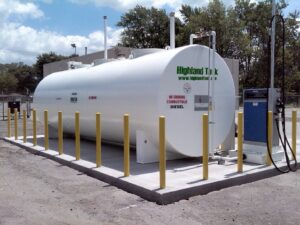 Above-ground Storage Tanks (AST) are tanks that are aboveground, regardless of whether they are used for to store petroleum products, hazardous waste, or other hazardous material. AST’s used for the store of petroleum products is regulated primarily under 40 CFR 112. The regulation does not actually use the terms “aboveground storage tank.” Instead the term “bulk storage container” is used and is defined as “any container used to store oil. These containers are used for purposes including, but not limited to, the storage of oil prior to use, while being used, or prior to further distribution in commerce. Oil-filled electrical, operating, or manufacturing equipment is not a bulk storage container.” A bulk storage container is 55 gal. or greater and may be aboveground, partially buried, bunkered, or completely buried. “Bunkered tanks” are defined as “a container constructed or placed in the ground by cutting the earth and re-covering the container in a manner that breaks the surrounding natural grade, or that lies above grade, and is covered with earth, sand, gravel, asphalt, or other material. A bunkered tank is considered an aboveground storage container for purposes of 40 CFR 112″Below are some spill prevention tips that go beyond the federal regulations under 40 CFR Part 112, but are highly recommended by EPA.
Above-ground Storage Tanks (AST) are tanks that are aboveground, regardless of whether they are used for to store petroleum products, hazardous waste, or other hazardous material. AST’s used for the store of petroleum products is regulated primarily under 40 CFR 112. The regulation does not actually use the terms “aboveground storage tank.” Instead the term “bulk storage container” is used and is defined as “any container used to store oil. These containers are used for purposes including, but not limited to, the storage of oil prior to use, while being used, or prior to further distribution in commerce. Oil-filled electrical, operating, or manufacturing equipment is not a bulk storage container.” A bulk storage container is 55 gal. or greater and may be aboveground, partially buried, bunkered, or completely buried. “Bunkered tanks” are defined as “a container constructed or placed in the ground by cutting the earth and re-covering the container in a manner that breaks the surrounding natural grade, or that lies above grade, and is covered with earth, sand, gravel, asphalt, or other material. A bunkered tank is considered an aboveground storage container for purposes of 40 CFR 112″Below are some spill prevention tips that go beyond the federal regulations under 40 CFR Part 112, but are highly recommended by EPA.
Facility Location – The location of the facility must be considered in relation to drinking water wells, streams, ponds and ditches (perennial or intermittent), storm or sanitary sewers, wetlands, mudflats, sandflats, farm drain tiles, or other navigable waters. The distance to drinking water wells and surface water, volume of material stored, worse case weather conditions, drainage patterns, land contours, and soil conditions must also be taken into account. Regular maintenance done by a well services company will also keep your water well clean and functioning properly.
Corrosion Control – ASTs should have corrosion protection for the tank. Options include elevating tanks, resting tanks on continuous concrete slabs, installing double-walled tanks, cathodically protecting the tanks, internally lining tanks, inspecting tanks according to American Petroleum Institute standard, or a combination of the options listed above. All underground piping to the tank should be double-walled or located above ground or cathodically protected so you can inspect it when it fails. To maximize system safety, seal the floors, containment area, and sump pump pit with an appropriate coating such as black oxide product coating or petroleum resistant coating. Any accumulated water should be inspected for petroleum or chemicals prior to discharge. If the asphalt surfaces in your facility have already been damaged, it is recommended to hire asphalt companies to do the repairs.
Periodic Cleanup – Accumulated minor spillage, over time, may result in a film or sheen on collected rain water, making it unsuitable for discharge to the soil or drains. Periodic cleanup of the containment areas (e.g., sweeping with a broom and using limited absorbent) can prevent unnecessary dirt and contaminant buildup.
Registration Programs – Local jurisdictions may want to implement registration programs for exempt tanks, in order to exercise some oversight of their construction and operation. Furthermore, most states also require inspections for ASTs by fire marshals. Inspection programs can be expanded to cover water contamination issues.
Preventing Evaporation – While not a preventative measure for source water protection, preventing evaporation has economic and air quality benefits. To keep out rain and reduce evaporation losses and moisture condensation, paint tanks a reflective color, install them in an east-west direction, install a low-pressure valve on top of the tank, and cover the structure. A roof structure covering a 10,000 gallon tank will conserve 600 to 1,000 gallons of gasoline per year, which would have escaped by evaporation without the shade cover.
—
Contact Us (859-689-9222) for a Free Consultation!
—
 About Environmental Risk Management
About Environmental Risk Management
1-Source Turnkey Environmental & Safety Services
Since 1989, Environmental Risk Management has been providing responsive, client focused 1-source turnkey solutions for a wide variety of environmental safety challenges. With our experience and extensive network of diverse internal and external resources, our clients trust us to provide quality Environmental & Safety Services for their businesses. Our environmental compliance specialists recognize the need to consult with private industry and the business community and our goal is to ensurer our client’s are complying with complex environmental regulations and minimizing their environmental liabilities.
> Learn More
